Event Management: Initial Planning Stages and World Cup 2018 Analysis
VerifiedAdded on 2020/04/21
|8
|2337
|90
Report
AI Summary
This report provides a comprehensive overview of event management, defining it as the strategic application of organizational and business skills to envision, plan, coordinate, and implement various events, from social gatherings to corporate conferences and major tournaments like the 2018 World Cup in Russia. The report traces the evolution of event management, highlighting the increasing reliance on it as a strategic tool for businesses and social entities. It details the importance of setting clear objectives, goals, and a vision for events, emphasizing the value of experience, visualization, and budgeting. The report uses the DRIVE program as an event planning guide. It also examines the application of these principles to the 2018 World Cup, focusing on the FIFA's sustainability objectives, including health and safety, green building standards, ethical business practices, and local economic development. The report highlights the strategies employed to meet these objectives, such as stakeholder engagement, awareness campaigns, and educational programs. The report concludes by emphasizing the broader environmental benefits of sustainable practices.
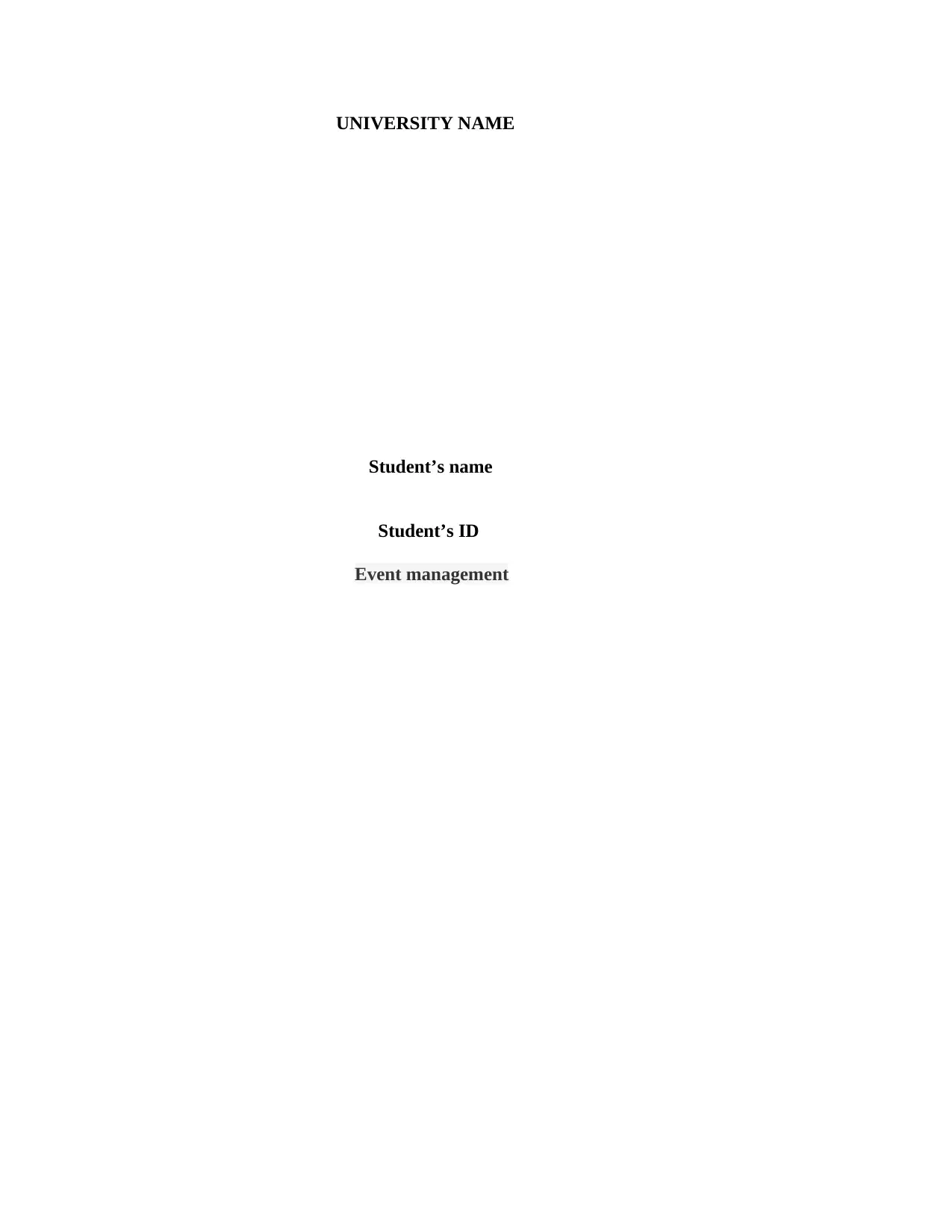
UNIVERSITY NAME
Student’s name
Student’s ID
Event management
Student’s name
Student’s ID
Event management
Paraphrase This Document
Need a fresh take? Get an instant paraphrase of this document with our AI Paraphraser
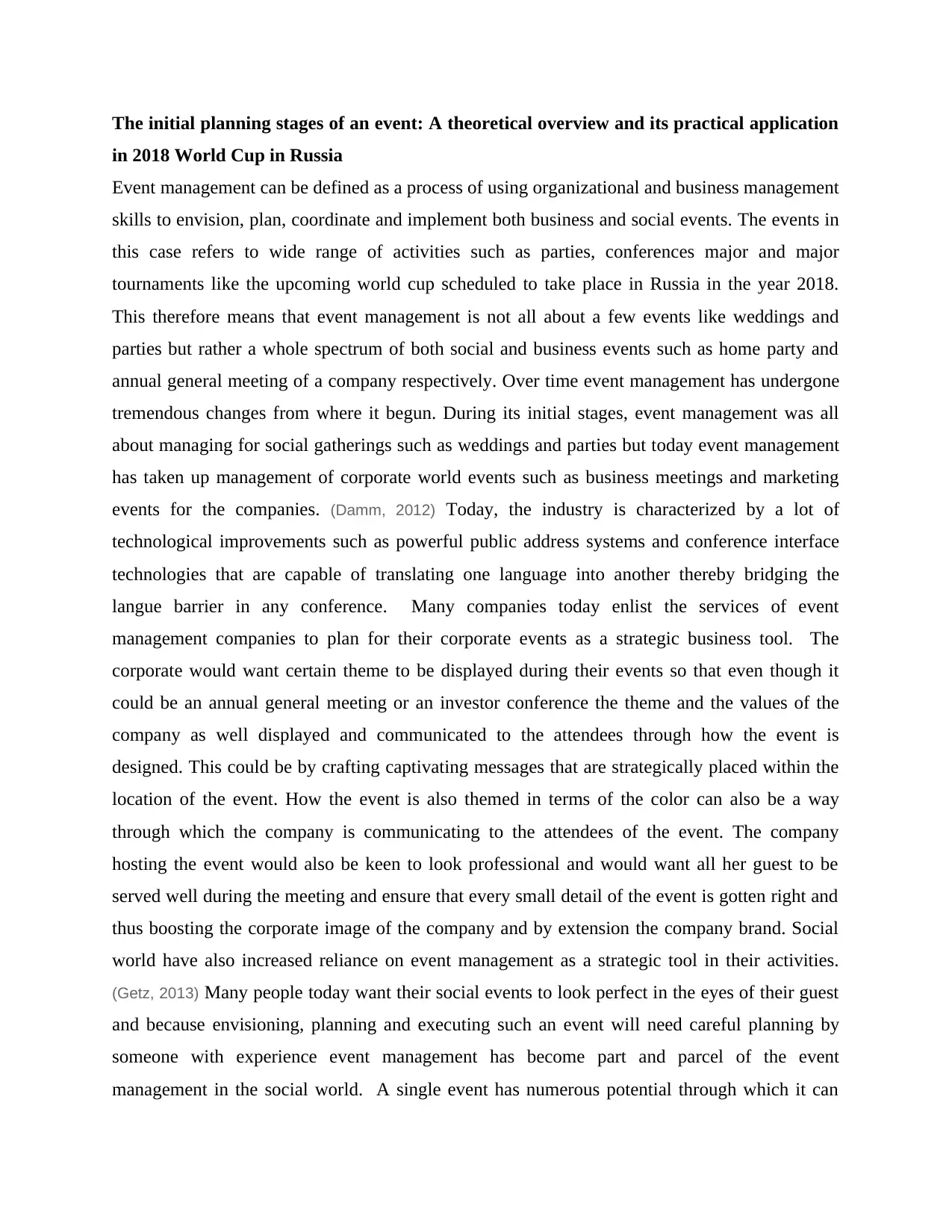
The initial planning stages of an event: A theoretical overview and its practical application
in 2018 World Cup in Russia
Event management can be defined as a process of using organizational and business management
skills to envision, plan, coordinate and implement both business and social events. The events in
this case refers to wide range of activities such as parties, conferences major and major
tournaments like the upcoming world cup scheduled to take place in Russia in the year 2018.
This therefore means that event management is not all about a few events like weddings and
parties but rather a whole spectrum of both social and business events such as home party and
annual general meeting of a company respectively. Over time event management has undergone
tremendous changes from where it begun. During its initial stages, event management was all
about managing for social gatherings such as weddings and parties but today event management
has taken up management of corporate world events such as business meetings and marketing
events for the companies. (Damm, 2012) Today, the industry is characterized by a lot of
technological improvements such as powerful public address systems and conference interface
technologies that are capable of translating one language into another thereby bridging the
langue barrier in any conference. Many companies today enlist the services of event
management companies to plan for their corporate events as a strategic business tool. The
corporate would want certain theme to be displayed during their events so that even though it
could be an annual general meeting or an investor conference the theme and the values of the
company as well displayed and communicated to the attendees through how the event is
designed. This could be by crafting captivating messages that are strategically placed within the
location of the event. How the event is also themed in terms of the color can also be a way
through which the company is communicating to the attendees of the event. The company
hosting the event would also be keen to look professional and would want all her guest to be
served well during the meeting and ensure that every small detail of the event is gotten right and
thus boosting the corporate image of the company and by extension the company brand. Social
world have also increased reliance on event management as a strategic tool in their activities.
(Getz, 2013) Many people today want their social events to look perfect in the eyes of their guest
and because envisioning, planning and executing such an event will need careful planning by
someone with experience event management has become part and parcel of the event
management in the social world. A single event has numerous potential through which it can
in 2018 World Cup in Russia
Event management can be defined as a process of using organizational and business management
skills to envision, plan, coordinate and implement both business and social events. The events in
this case refers to wide range of activities such as parties, conferences major and major
tournaments like the upcoming world cup scheduled to take place in Russia in the year 2018.
This therefore means that event management is not all about a few events like weddings and
parties but rather a whole spectrum of both social and business events such as home party and
annual general meeting of a company respectively. Over time event management has undergone
tremendous changes from where it begun. During its initial stages, event management was all
about managing for social gatherings such as weddings and parties but today event management
has taken up management of corporate world events such as business meetings and marketing
events for the companies. (Damm, 2012) Today, the industry is characterized by a lot of
technological improvements such as powerful public address systems and conference interface
technologies that are capable of translating one language into another thereby bridging the
langue barrier in any conference. Many companies today enlist the services of event
management companies to plan for their corporate events as a strategic business tool. The
corporate would want certain theme to be displayed during their events so that even though it
could be an annual general meeting or an investor conference the theme and the values of the
company as well displayed and communicated to the attendees through how the event is
designed. This could be by crafting captivating messages that are strategically placed within the
location of the event. How the event is also themed in terms of the color can also be a way
through which the company is communicating to the attendees of the event. The company
hosting the event would also be keen to look professional and would want all her guest to be
served well during the meeting and ensure that every small detail of the event is gotten right and
thus boosting the corporate image of the company and by extension the company brand. Social
world have also increased reliance on event management as a strategic tool in their activities.
(Getz, 2013) Many people today want their social events to look perfect in the eyes of their guest
and because envisioning, planning and executing such an event will need careful planning by
someone with experience event management has become part and parcel of the event
management in the social world. A single event has numerous potential through which it can
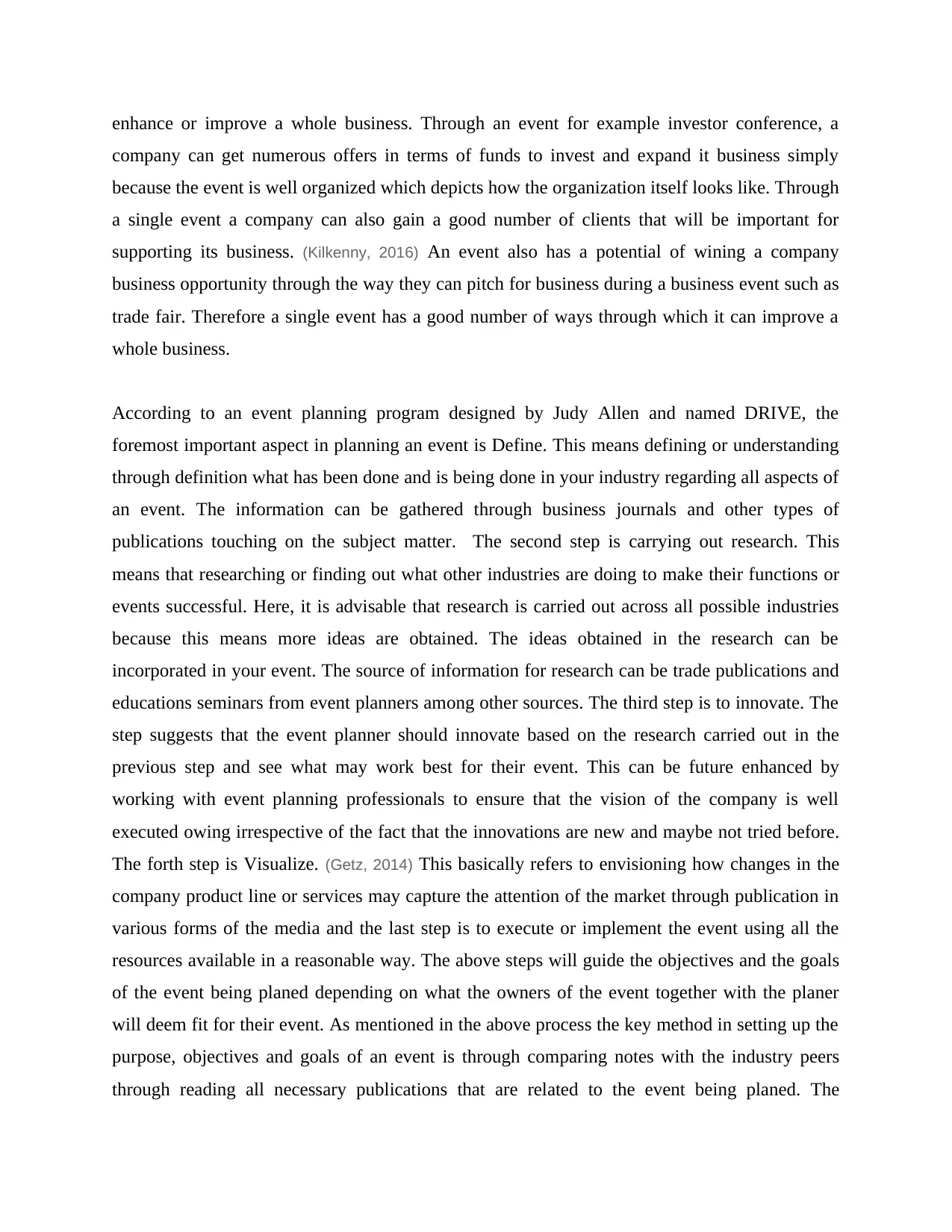
enhance or improve a whole business. Through an event for example investor conference, a
company can get numerous offers in terms of funds to invest and expand it business simply
because the event is well organized which depicts how the organization itself looks like. Through
a single event a company can also gain a good number of clients that will be important for
supporting its business. (Kilkenny, 2016) An event also has a potential of wining a company
business opportunity through the way they can pitch for business during a business event such as
trade fair. Therefore a single event has a good number of ways through which it can improve a
whole business.
According to an event planning program designed by Judy Allen and named DRIVE, the
foremost important aspect in planning an event is Define. This means defining or understanding
through definition what has been done and is being done in your industry regarding all aspects of
an event. The information can be gathered through business journals and other types of
publications touching on the subject matter. The second step is carrying out research. This
means that researching or finding out what other industries are doing to make their functions or
events successful. Here, it is advisable that research is carried out across all possible industries
because this means more ideas are obtained. The ideas obtained in the research can be
incorporated in your event. The source of information for research can be trade publications and
educations seminars from event planners among other sources. The third step is to innovate. The
step suggests that the event planner should innovate based on the research carried out in the
previous step and see what may work best for their event. This can be future enhanced by
working with event planning professionals to ensure that the vision of the company is well
executed owing irrespective of the fact that the innovations are new and maybe not tried before.
The forth step is Visualize. (Getz, 2014) This basically refers to envisioning how changes in the
company product line or services may capture the attention of the market through publication in
various forms of the media and the last step is to execute or implement the event using all the
resources available in a reasonable way. The above steps will guide the objectives and the goals
of the event being planed depending on what the owners of the event together with the planer
will deem fit for their event. As mentioned in the above process the key method in setting up the
purpose, objectives and goals of an event is through comparing notes with the industry peers
through reading all necessary publications that are related to the event being planed. The
company can get numerous offers in terms of funds to invest and expand it business simply
because the event is well organized which depicts how the organization itself looks like. Through
a single event a company can also gain a good number of clients that will be important for
supporting its business. (Kilkenny, 2016) An event also has a potential of wining a company
business opportunity through the way they can pitch for business during a business event such as
trade fair. Therefore a single event has a good number of ways through which it can improve a
whole business.
According to an event planning program designed by Judy Allen and named DRIVE, the
foremost important aspect in planning an event is Define. This means defining or understanding
through definition what has been done and is being done in your industry regarding all aspects of
an event. The information can be gathered through business journals and other types of
publications touching on the subject matter. The second step is carrying out research. This
means that researching or finding out what other industries are doing to make their functions or
events successful. Here, it is advisable that research is carried out across all possible industries
because this means more ideas are obtained. The ideas obtained in the research can be
incorporated in your event. The source of information for research can be trade publications and
educations seminars from event planners among other sources. The third step is to innovate. The
step suggests that the event planner should innovate based on the research carried out in the
previous step and see what may work best for their event. This can be future enhanced by
working with event planning professionals to ensure that the vision of the company is well
executed owing irrespective of the fact that the innovations are new and maybe not tried before.
The forth step is Visualize. (Getz, 2014) This basically refers to envisioning how changes in the
company product line or services may capture the attention of the market through publication in
various forms of the media and the last step is to execute or implement the event using all the
resources available in a reasonable way. The above steps will guide the objectives and the goals
of the event being planed depending on what the owners of the event together with the planer
will deem fit for their event. As mentioned in the above process the key method in setting up the
purpose, objectives and goals of an event is through comparing notes with the industry peers
through reading all necessary publications that are related to the event being planed. The
⊘ This is a preview!⊘
Do you want full access?
Subscribe today to unlock all pages.

Trusted by 1+ million students worldwide
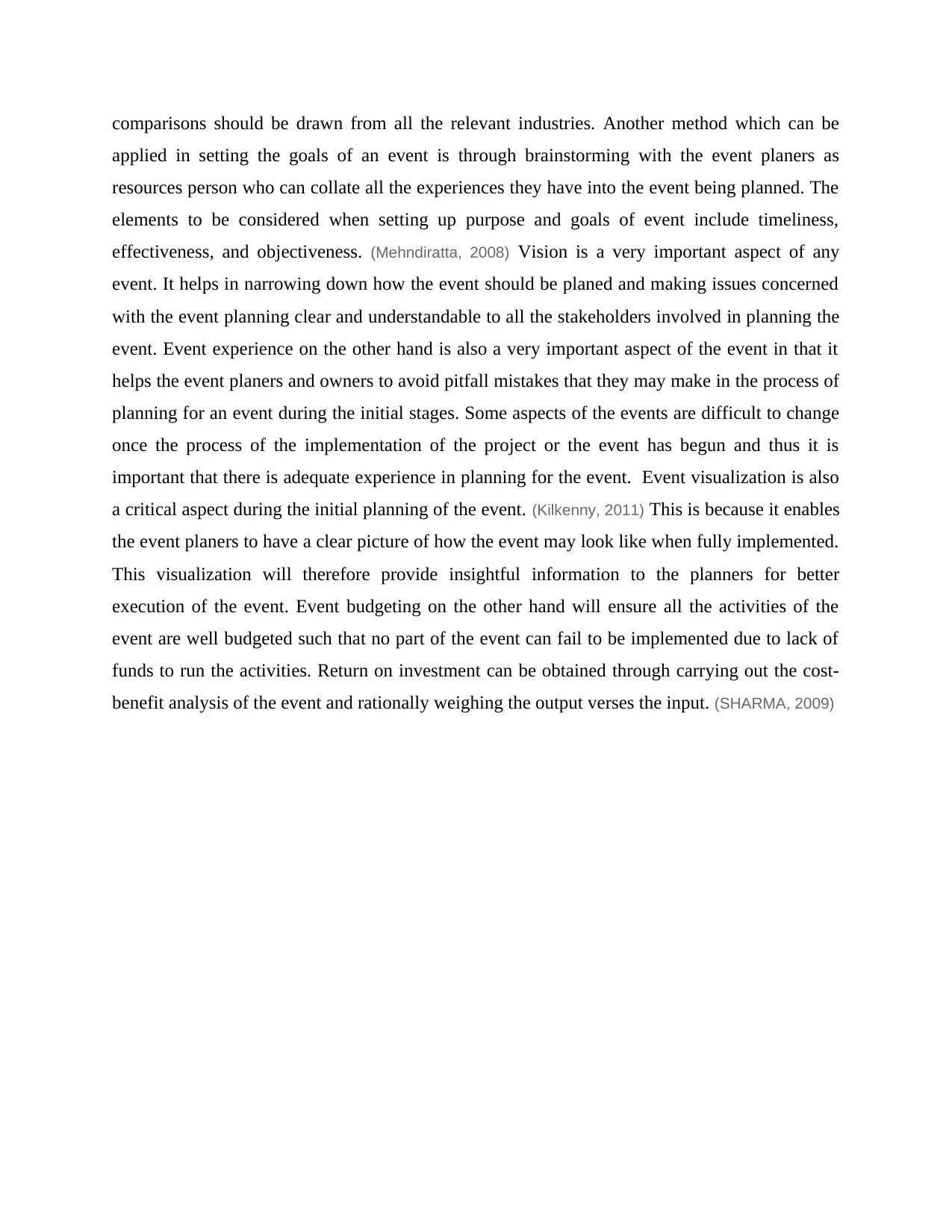
comparisons should be drawn from all the relevant industries. Another method which can be
applied in setting the goals of an event is through brainstorming with the event planers as
resources person who can collate all the experiences they have into the event being planned. The
elements to be considered when setting up purpose and goals of event include timeliness,
effectiveness, and objectiveness. (Mehndiratta, 2008) Vision is a very important aspect of any
event. It helps in narrowing down how the event should be planed and making issues concerned
with the event planning clear and understandable to all the stakeholders involved in planning the
event. Event experience on the other hand is also a very important aspect of the event in that it
helps the event planers and owners to avoid pitfall mistakes that they may make in the process of
planning for an event during the initial stages. Some aspects of the events are difficult to change
once the process of the implementation of the project or the event has begun and thus it is
important that there is adequate experience in planning for the event. Event visualization is also
a critical aspect during the initial planning of the event. (Kilkenny, 2011) This is because it enables
the event planers to have a clear picture of how the event may look like when fully implemented.
This visualization will therefore provide insightful information to the planners for better
execution of the event. Event budgeting on the other hand will ensure all the activities of the
event are well budgeted such that no part of the event can fail to be implemented due to lack of
funds to run the activities. Return on investment can be obtained through carrying out the cost-
benefit analysis of the event and rationally weighing the output verses the input. (SHARMA, 2009)
applied in setting the goals of an event is through brainstorming with the event planers as
resources person who can collate all the experiences they have into the event being planned. The
elements to be considered when setting up purpose and goals of event include timeliness,
effectiveness, and objectiveness. (Mehndiratta, 2008) Vision is a very important aspect of any
event. It helps in narrowing down how the event should be planed and making issues concerned
with the event planning clear and understandable to all the stakeholders involved in planning the
event. Event experience on the other hand is also a very important aspect of the event in that it
helps the event planers and owners to avoid pitfall mistakes that they may make in the process of
planning for an event during the initial stages. Some aspects of the events are difficult to change
once the process of the implementation of the project or the event has begun and thus it is
important that there is adequate experience in planning for the event. Event visualization is also
a critical aspect during the initial planning of the event. (Kilkenny, 2011) This is because it enables
the event planers to have a clear picture of how the event may look like when fully implemented.
This visualization will therefore provide insightful information to the planners for better
execution of the event. Event budgeting on the other hand will ensure all the activities of the
event are well budgeted such that no part of the event can fail to be implemented due to lack of
funds to run the activities. Return on investment can be obtained through carrying out the cost-
benefit analysis of the event and rationally weighing the output verses the input. (SHARMA, 2009)
Paraphrase This Document
Need a fresh take? Get an instant paraphrase of this document with our AI Paraphraser
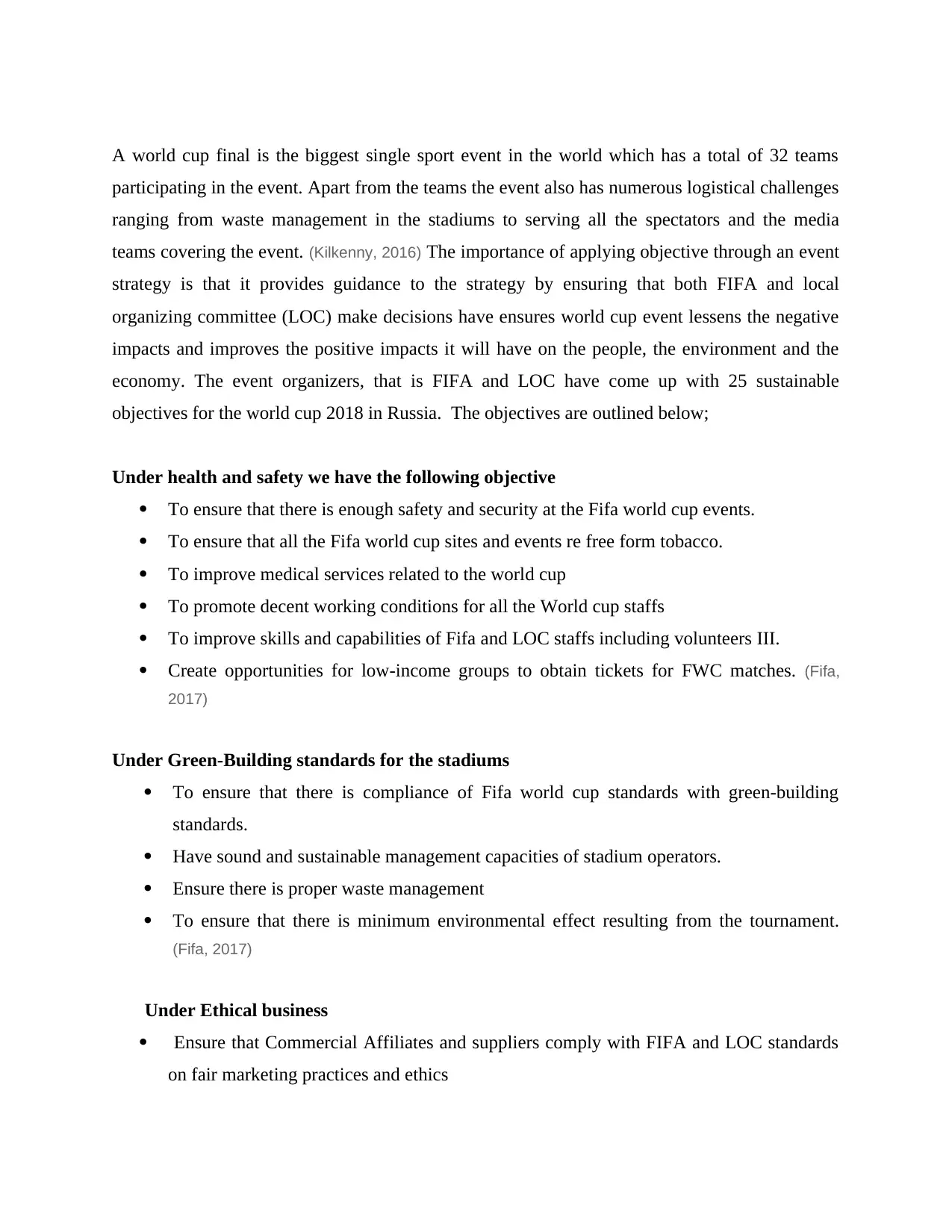
A world cup final is the biggest single sport event in the world which has a total of 32 teams
participating in the event. Apart from the teams the event also has numerous logistical challenges
ranging from waste management in the stadiums to serving all the spectators and the media
teams covering the event. (Kilkenny, 2016) The importance of applying objective through an event
strategy is that it provides guidance to the strategy by ensuring that both FIFA and local
organizing committee (LOC) make decisions have ensures world cup event lessens the negative
impacts and improves the positive impacts it will have on the people, the environment and the
economy. The event organizers, that is FIFA and LOC have come up with 25 sustainable
objectives for the world cup 2018 in Russia. The objectives are outlined below;
Under health and safety we have the following objective
To ensure that there is enough safety and security at the Fifa world cup events.
To ensure that all the Fifa world cup sites and events re free form tobacco.
To improve medical services related to the world cup
To promote decent working conditions for all the World cup staffs
To improve skills and capabilities of Fifa and LOC staffs including volunteers III.
Create opportunities for low-income groups to obtain tickets for FWC matches. (Fifa,
2017)
Under Green-Building standards for the stadiums
To ensure that there is compliance of Fifa world cup standards with green-building
standards.
Have sound and sustainable management capacities of stadium operators.
Ensure there is proper waste management
To ensure that there is minimum environmental effect resulting from the tournament.
(Fifa, 2017)
Under Ethical business
Ensure that Commercial Affiliates and suppliers comply with FIFA and LOC standards
on fair marketing practices and ethics
participating in the event. Apart from the teams the event also has numerous logistical challenges
ranging from waste management in the stadiums to serving all the spectators and the media
teams covering the event. (Kilkenny, 2016) The importance of applying objective through an event
strategy is that it provides guidance to the strategy by ensuring that both FIFA and local
organizing committee (LOC) make decisions have ensures world cup event lessens the negative
impacts and improves the positive impacts it will have on the people, the environment and the
economy. The event organizers, that is FIFA and LOC have come up with 25 sustainable
objectives for the world cup 2018 in Russia. The objectives are outlined below;
Under health and safety we have the following objective
To ensure that there is enough safety and security at the Fifa world cup events.
To ensure that all the Fifa world cup sites and events re free form tobacco.
To improve medical services related to the world cup
To promote decent working conditions for all the World cup staffs
To improve skills and capabilities of Fifa and LOC staffs including volunteers III.
Create opportunities for low-income groups to obtain tickets for FWC matches. (Fifa,
2017)
Under Green-Building standards for the stadiums
To ensure that there is compliance of Fifa world cup standards with green-building
standards.
Have sound and sustainable management capacities of stadium operators.
Ensure there is proper waste management
To ensure that there is minimum environmental effect resulting from the tournament.
(Fifa, 2017)
Under Ethical business
Ensure that Commercial Affiliates and suppliers comply with FIFA and LOC standards
on fair marketing practices and ethics
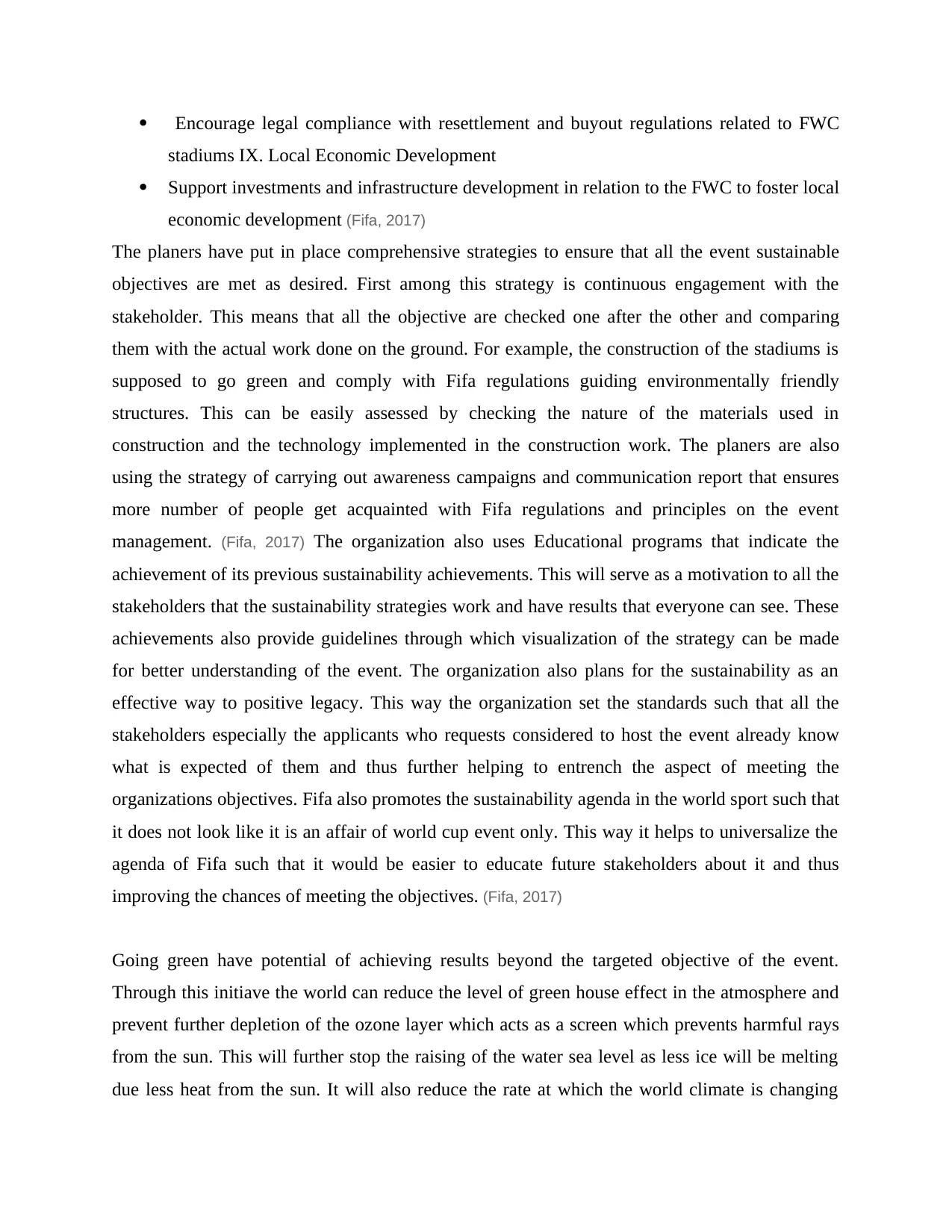
Encourage legal compliance with resettlement and buyout regulations related to FWC
stadiums IX. Local Economic Development
Support investments and infrastructure development in relation to the FWC to foster local
economic development (Fifa, 2017)
The planers have put in place comprehensive strategies to ensure that all the event sustainable
objectives are met as desired. First among this strategy is continuous engagement with the
stakeholder. This means that all the objective are checked one after the other and comparing
them with the actual work done on the ground. For example, the construction of the stadiums is
supposed to go green and comply with Fifa regulations guiding environmentally friendly
structures. This can be easily assessed by checking the nature of the materials used in
construction and the technology implemented in the construction work. The planers are also
using the strategy of carrying out awareness campaigns and communication report that ensures
more number of people get acquainted with Fifa regulations and principles on the event
management. (Fifa, 2017) The organization also uses Educational programs that indicate the
achievement of its previous sustainability achievements. This will serve as a motivation to all the
stakeholders that the sustainability strategies work and have results that everyone can see. These
achievements also provide guidelines through which visualization of the strategy can be made
for better understanding of the event. The organization also plans for the sustainability as an
effective way to positive legacy. This way the organization set the standards such that all the
stakeholders especially the applicants who requests considered to host the event already know
what is expected of them and thus further helping to entrench the aspect of meeting the
organizations objectives. Fifa also promotes the sustainability agenda in the world sport such that
it does not look like it is an affair of world cup event only. This way it helps to universalize the
agenda of Fifa such that it would be easier to educate future stakeholders about it and thus
improving the chances of meeting the objectives. (Fifa, 2017)
Going green have potential of achieving results beyond the targeted objective of the event.
Through this initiave the world can reduce the level of green house effect in the atmosphere and
prevent further depletion of the ozone layer which acts as a screen which prevents harmful rays
from the sun. This will further stop the raising of the water sea level as less ice will be melting
due less heat from the sun. It will also reduce the rate at which the world climate is changing
stadiums IX. Local Economic Development
Support investments and infrastructure development in relation to the FWC to foster local
economic development (Fifa, 2017)
The planers have put in place comprehensive strategies to ensure that all the event sustainable
objectives are met as desired. First among this strategy is continuous engagement with the
stakeholder. This means that all the objective are checked one after the other and comparing
them with the actual work done on the ground. For example, the construction of the stadiums is
supposed to go green and comply with Fifa regulations guiding environmentally friendly
structures. This can be easily assessed by checking the nature of the materials used in
construction and the technology implemented in the construction work. The planers are also
using the strategy of carrying out awareness campaigns and communication report that ensures
more number of people get acquainted with Fifa regulations and principles on the event
management. (Fifa, 2017) The organization also uses Educational programs that indicate the
achievement of its previous sustainability achievements. This will serve as a motivation to all the
stakeholders that the sustainability strategies work and have results that everyone can see. These
achievements also provide guidelines through which visualization of the strategy can be made
for better understanding of the event. The organization also plans for the sustainability as an
effective way to positive legacy. This way the organization set the standards such that all the
stakeholders especially the applicants who requests considered to host the event already know
what is expected of them and thus further helping to entrench the aspect of meeting the
organizations objectives. Fifa also promotes the sustainability agenda in the world sport such that
it does not look like it is an affair of world cup event only. This way it helps to universalize the
agenda of Fifa such that it would be easier to educate future stakeholders about it and thus
improving the chances of meeting the objectives. (Fifa, 2017)
Going green have potential of achieving results beyond the targeted objective of the event.
Through this initiave the world can reduce the level of green house effect in the atmosphere and
prevent further depletion of the ozone layer which acts as a screen which prevents harmful rays
from the sun. This will further stop the raising of the water sea level as less ice will be melting
due less heat from the sun. It will also reduce the rate at which the world climate is changing
⊘ This is a preview!⊘
Do you want full access?
Subscribe today to unlock all pages.

Trusted by 1+ million students worldwide

which affects plans and animals depending rain as a major source of water. Therefore apart from
meeting the objective of the Fifa environmentally going green has other potential advantages to
the world weather and climate.
meeting the objective of the Fifa environmentally going green has other potential advantages to
the world weather and climate.
Paraphrase This Document
Need a fresh take? Get an instant paraphrase of this document with our AI Paraphraser
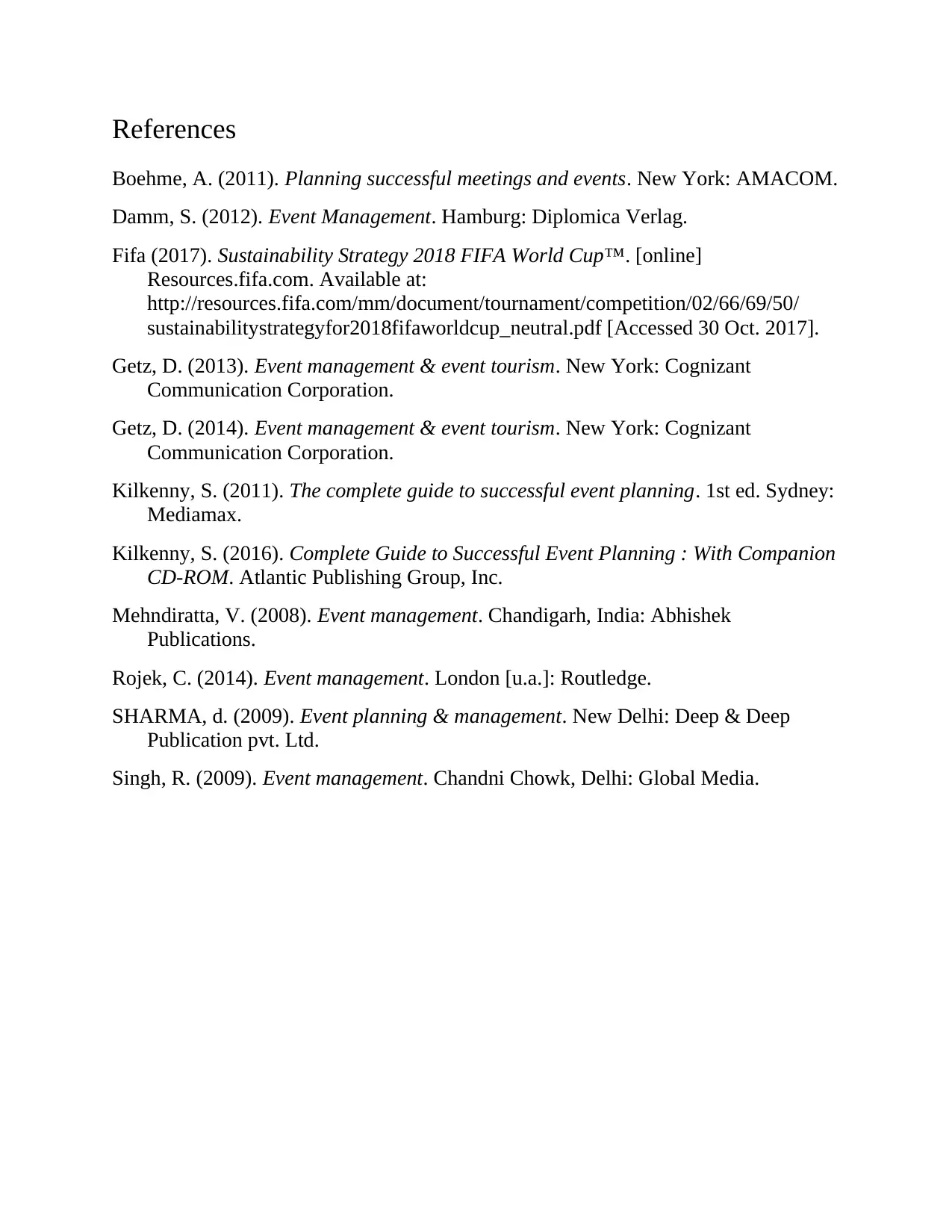
References
Boehme, A. (2011). Planning successful meetings and events. New York: AMACOM.
Damm, S. (2012). Event Management. Hamburg: Diplomica Verlag.
Fifa (2017). Sustainability Strategy 2018 FIFA World Cup™. [online]
Resources.fifa.com. Available at:
http://resources.fifa.com/mm/document/tournament/competition/02/66/69/50/
sustainabilitystrategyfor2018fifaworldcup_neutral.pdf [Accessed 30 Oct. 2017].
Getz, D. (2013). Event management & event tourism. New York: Cognizant
Communication Corporation.
Getz, D. (2014). Event management & event tourism. New York: Cognizant
Communication Corporation.
Kilkenny, S. (2011). The complete guide to successful event planning. 1st ed. Sydney:
Mediamax.
Kilkenny, S. (2016). Complete Guide to Successful Event Planning : With Companion
CD-ROM. Atlantic Publishing Group, Inc.
Mehndiratta, V. (2008). Event management. Chandigarh, India: Abhishek
Publications.
Rojek, C. (2014). Event management. London [u.a.]: Routledge.
SHARMA, d. (2009). Event planning & management. New Delhi: Deep & Deep
Publication pvt. Ltd.
Singh, R. (2009). Event management. Chandni Chowk, Delhi: Global Media.
Boehme, A. (2011). Planning successful meetings and events. New York: AMACOM.
Damm, S. (2012). Event Management. Hamburg: Diplomica Verlag.
Fifa (2017). Sustainability Strategy 2018 FIFA World Cup™. [online]
Resources.fifa.com. Available at:
http://resources.fifa.com/mm/document/tournament/competition/02/66/69/50/
sustainabilitystrategyfor2018fifaworldcup_neutral.pdf [Accessed 30 Oct. 2017].
Getz, D. (2013). Event management & event tourism. New York: Cognizant
Communication Corporation.
Getz, D. (2014). Event management & event tourism. New York: Cognizant
Communication Corporation.
Kilkenny, S. (2011). The complete guide to successful event planning. 1st ed. Sydney:
Mediamax.
Kilkenny, S. (2016). Complete Guide to Successful Event Planning : With Companion
CD-ROM. Atlantic Publishing Group, Inc.
Mehndiratta, V. (2008). Event management. Chandigarh, India: Abhishek
Publications.
Rojek, C. (2014). Event management. London [u.a.]: Routledge.
SHARMA, d. (2009). Event planning & management. New Delhi: Deep & Deep
Publication pvt. Ltd.
Singh, R. (2009). Event management. Chandni Chowk, Delhi: Global Media.
1 out of 8
Related Documents
Your All-in-One AI-Powered Toolkit for Academic Success.
+13062052269
info@desklib.com
Available 24*7 on WhatsApp / Email
![[object Object]](/_next/static/media/star-bottom.7253800d.svg)
Unlock your academic potential
Copyright © 2020–2025 A2Z Services. All Rights Reserved. Developed and managed by ZUCOL.



